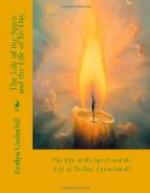“We behold that which we are!” said Ruysbroeck long ago.[82] The mind’s content and its ruling feeling-tone, says psychology, all its memories and desires, mingle with all incoming impressions, colour them and condition those which our consciousness selects. This intervention of memory and emotion in our perceptions is entirely involuntary; and explains why the devotee of any specific creed always finds in the pure immediacy of religious experience the special marks of his own belief. In most acts of perception—and probably, too, in the intuitional awareness of religious experience—that which the mind brings is bulkier if less important than that which it receives; and only the closest analysis will enable us to separate these two elements. Yet this machinery of apperception—humbling though its realization must be to the eager idealist—does not merely confuse the issue for us; or compel us to agnosticism as to the true content of religious intuition. On the contrary, its comprehension gives us the clue to many theological puzzles; whilst its existence enables us to lay hold of supersensual experiences we should otherwise miss, because it gives to us the means of interpreting them. Pure immediacy, as such, is almost ungraspable by us. As man, not as pure spirit, the High Priest entered the Holy of Holies: that is to say, he took to the encounter of the Infinite the finite machinery of sense. This limitation is ignored by us at our peril. The great mystics, who have sought to strip off all image and reach—as they say—the Bare Pure Truth, have merely become inarticulate in their effort to tell us what it was that they knew. “A light I cannot measure, goodness without form!” exclaims Jacopone da Todi.[83] “The Light of the World—the Good Shepherd,” says St. John, bringing a richly furnished poetic consciousness to the vision of God; and at once gives us something on which to lay hold.




